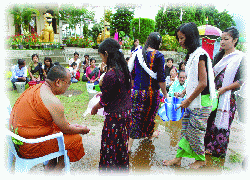Archives
Maha Sangken
who follow Thereveda or Hinnayana Buddhism. This festival generally falls in the month of “Naun Ha” (Fifth month of the year) of the Tai Khampti calendar and corresponds with the Sankranthi of Baisakh. This day is celebrated with great devotion and enthusiasm and is also marked as a farewell to the old year and a welcoming of the New Year for the people of this sect of Theravada Buddhism.
The preparation for the festival includes construction of Kyongfra (temporary shrine) for keeping the idols of Buddha during Sangken. It is generally constructed with bamboo and leaves and decorated with flowers and decorative paper. In this Kyongfra, clean water is sprinkled through the Loungkong, a specially designed water fountain which is connected to a Hoelin, a boat shaped wooden structure. Water poured on the Hoelin rushes to the Loungkong and causes a rotary movement to the Loungkong. With this rotary movement of the Loungkong, clean and scented water is sprinkled over the idols kept around it inside the Kyongfra.  Clean and scented water is also sprinkled on the idols of Buddha which are kept on a special platform. Water is also poured over all the holy objects including the Boddhi tree, the Sailik (ropes of the holy book), Chausangpha upuk and the Sammukkathing. Water is poured on the hands of the Bhikkhus seeking blessing.
Clean and scented water is also sprinkled on the idols of Buddha which are kept on a special platform. Water is also poured over all the holy objects including the Boddhi tree, the Sailik (ropes of the holy book), Chausangpha upuk and the Sammukkathing. Water is poured on the hands of the Bhikkhus seeking blessing.
After sprinkling and pouring water (sonphra) people make fun and merriment by pouring water over each other. Water is also poured over the feet and hands of the respected and elderly people for blessing.
As Sangken is a festival to invoke the blessing of Lord Buddha for the protection of mankind from evil, clean scented water and flowers are showered over the images of Lord Buddha to invoke His blessing for peace, harmony, good luck and good health to mankind. Pouring and washing the hands and feet of the respected ones is also done to invoke the blessing for good luck, good health, peace and harmony throughout the New Year. During the celebration of the Sangken the people of the Therevada Buddhist Sect observe certain rules which include: - abstinence from killing, abstinence from stealing, abstinence from lying, abstinence from taking intoxicants, abstinence from cutting trees, abstinence from indulging in sexual misconduct, abstinence from getting involved in a dispute, abstinence from conducting business transactions, abstinence from gossip and criticising others.
The above taboos observed during Sangken as observance of the Silas which generally follow all kinds of Danas .gif) (offering) is also for peace and harmony. At the end of the celebration the duration of which is as per astrological calculation, images of Lord Buddha are taken back to the Vihara (temple). The idols are cleaned with sandal oil and scented water before being restored to the original shrine inside the Vihara. Restoration of the idols of Lord Buddha to the original Shrine marks the end or Ring out of the old year and beginning or “Ring In” of the New Year. Poi-Sangken follows the celebration of Sangken which is mainly a concluding function of the celebration. A community feast is arranged during Poi Sangken and people enjoy the evening with a variety of performances, one act-plays and cinema etc. On the next day in the morning people congregate inside the Vihara for Khamsin-Thomtra, observance of Panchsheela and paying obeisance to Buddha, Dharma and Sanggha. The whole celebration comes to an end with people wishing each other peace, good luck, good health and harmony and prosperity of mankind through out the New Year. The whole celebration lasts for three days.
(offering) is also for peace and harmony. At the end of the celebration the duration of which is as per astrological calculation, images of Lord Buddha are taken back to the Vihara (temple). The idols are cleaned with sandal oil and scented water before being restored to the original shrine inside the Vihara. Restoration of the idols of Lord Buddha to the original Shrine marks the end or Ring out of the old year and beginning or “Ring In” of the New Year. Poi-Sangken follows the celebration of Sangken which is mainly a concluding function of the celebration. A community feast is arranged during Poi Sangken and people enjoy the evening with a variety of performances, one act-plays and cinema etc. On the next day in the morning people congregate inside the Vihara for Khamsin-Thomtra, observance of Panchsheela and paying obeisance to Buddha, Dharma and Sanggha. The whole celebration comes to an end with people wishing each other peace, good luck, good health and harmony and prosperity of mankind through out the New Year. The whole celebration lasts for three days.
Chow Bilaseng Namchoom

